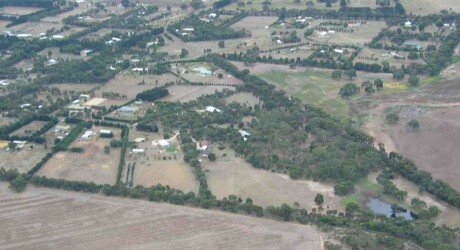The proposed extraction area begins just to the right of this photograph of the east end of Teesdale. Photographer: Neil Aird.
This article was published in the Geelong Advertiser on Tuesday, 22 March 2011, p. 18.
By Roy Hay
An application to quarry sand on the very edge of Teesdale has the locals up in arms. While it is always easy to label protesters as NIMBYs (Not in my back yard), in this case the proposal would seem to conflict directly with the Shire of Golden Plains’ own vision and strategic plans. The vision is broad and amorphous enough, like most such statements, talking about offering a lifestyle and opportunities that foster social and economic wellbeing … to improve the quality of life of residents. But the specific planning to achieve this has more substance and this is where the conflict arises.
The Shire adopted a Rural Land Use Strategy report by Parsons Brinckerhoff Australia Pty Ltd in January 2008 which included the following objective: ‘Provide for value adding rural industries, including intensive animal industries, where they can be sited so as to avoid conflicts and impacts on towns and settlements, residential uses, other agriculture uses and identified environmental values.’
The report drew on another study by DPS Dawson Planning Services Ltd and GMR Engineering Pty Ltd in September 2006 which mentioned a buffer area around towns of 3–5 kilometres for intensive agriculture, that is primarily piggeries and poultry farms. One might think that a sand quarry might be subject to the same or a similar buffer. The current application is for 5 hectares of land within a hundred or so metres of existing houses on the edge of the village. If the wind is from the east then the amount of dust and dirt blowing through the village, might produce similar effects to those of the Fyansford Cement Works in its heyday.
If this proposal goes ahead it will be very difficult to prevent future developments of a similar type in close proximity to not only Teesdale but any other of the small villages which form the main basis of settlement in the rural parts of the shire. That really would change the attractiveness of Golden Plains to the people who are drawn to the area precisely because it is not a dense urban settlement.
But it is not just the impact on neighbouring property owners which is at stake here. The proposal will not generate local employment or economic advantage apart from that accruing to the owners of the land. Extractive industries are not labour intensive and they tend to have a finite life. The permit sought on this occasion only covers five years, but it is not clear what would happen then. Could it be renewed or would the locals be left with a big hole in the ground? The Shire’s Rural Land Use Plan says it is particularly important to ‘ensure that land uses and developments are sited and managed so as to ensure that they do not impact detrimentally on the quantity and quality of environmental flows in the Shire’s streams and watercourses.’
The proposed quarry will generate more heavy traffic on Bannockburn–Shelford Road which is currently breaking up regularly under the weight of existing trucks, which now includes large numbers of B-Doubles on a road not designed for such vehicles. One of the worst areas is on the stretch between the proposed quarry and Bannockburn. Teesdale residents were probably happy enough to learn that the local tip is to close in the middle of the year. Its access road is close to that of the proposed quarry but the tip site is much further from the village and it does not generate much heavy traffic.
It is unlikely that there would be close control or monitoring of the number of vehicles entering or leaving the quarry site in any day. There is a risk that the conditions of the application for three to four vehicles per day would not necessarily be carried out. Those vehicles have to turn right on leaving the proposed quarry close to a blind bend on a 100 km-per-hour stretch of road.
The geology of Golden Plains is very interesting and complex and it is certain that there are plenty of deposits of sand in accessible areas further from existing settlements. Perhaps the Shire Council should ask Murray Hume Excavations to seek a more appropriate sandpit in which to play.
Roy Hay lives at the other end of Teesdale.








Marnie Haig-Muir: Your review of the latest Rankin is right on the money, Roy. This book...